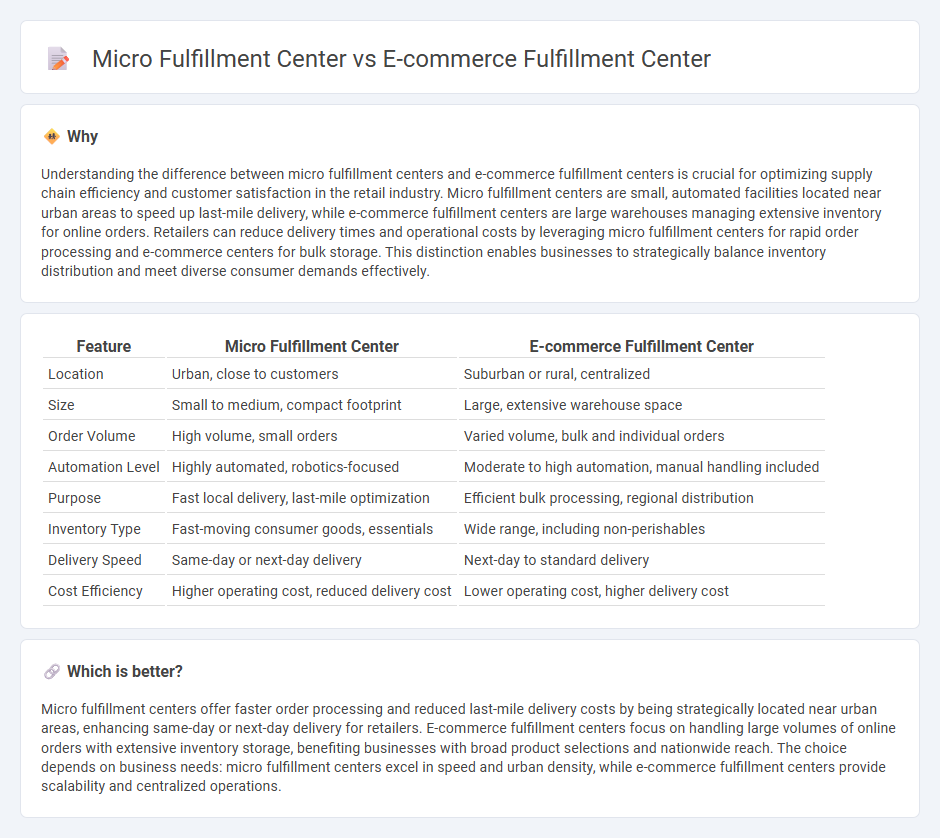
Micro fulfillment centers optimize last-mile delivery by utilizing compact warehouses within urban areas, speeding up order processing and reducing shipping costs. E-commerce fulfillment centers, often larger and located on city outskirts, handle vast inventories and streamline bulk order distribution through automated systems and extensive logistics networks. Explore how these fulfillment strategies transform retail efficiency and customer satisfaction.
Why it is important
Understanding the difference between micro fulfillment centers and e-commerce fulfillment centers is crucial for optimizing supply chain efficiency and customer satisfaction in the retail industry. Micro fulfillment centers are small, automated facilities located near urban areas to speed up last-mile delivery, while e-commerce fulfillment centers are large warehouses managing extensive inventory for online orders. Retailers can reduce delivery times and operational costs by leveraging micro fulfillment centers for rapid order processing and e-commerce centers for bulk storage. This distinction enables businesses to strategically balance inventory distribution and meet diverse consumer demands effectively.
Comparison Table
| Feature | Micro Fulfillment Center | E-commerce Fulfillment Center |
|---|---|---|
| Location | Urban, close to customers | Suburban or rural, centralized |
| Size | Small to medium, compact footprint | Large, extensive warehouse space |
| Order Volume | High volume, small orders | Varied volume, bulk and individual orders |
| Automation Level | Highly automated, robotics-focused | Moderate to high automation, manual handling included |
| Purpose | Fast local delivery, last-mile optimization | Efficient bulk processing, regional distribution |
| Inventory Type | Fast-moving consumer goods, essentials | Wide range, including non-perishables |
| Delivery Speed | Same-day or next-day delivery | Next-day to standard delivery |
| Cost Efficiency | Higher operating cost, reduced delivery cost | Lower operating cost, higher delivery cost |
Which is better?
Micro fulfillment centers offer faster order processing and reduced last-mile delivery costs by being strategically located near urban areas, enhancing same-day or next-day delivery for retailers. E-commerce fulfillment centers focus on handling large volumes of online orders with extensive inventory storage, benefiting businesses with broad product selections and nationwide reach. The choice depends on business needs: micro fulfillment centers excel in speed and urban density, while e-commerce fulfillment centers provide scalability and centralized operations.
Connection
Micro fulfillment centers (MFCs) and e-commerce fulfillment centers both serve as critical nodes in the retail supply chain, enabling faster order processing and delivery. MFCs are typically smaller, automated facilities located closer to urban consumers, designed to handle last-mile delivery efficiently, while e-commerce fulfillment centers are larger hubs managing inventory and bulk shipping. Their integration optimizes inventory flow and accelerates product availability, enhancing customer satisfaction in online retail.
Key Terms
Scale
E-commerce fulfillment centers handle large-scale inventory and distribution, optimizing for high-volume order processing with extensive storage space and automated sorting systems. Micro fulfillment centers prioritize speed and proximity, serving urban areas with compact facilities that enable faster last-mile delivery for smaller order quantities. Explore how choosing the right scale of fulfillment impacts your supply chain efficiency and customer satisfaction.
Location
E-commerce fulfillment centers are typically large-scale facilities located on city outskirts or rural areas to optimize space and reduce real estate costs, while micro fulfillment centers are compact units situated closer to urban consumers for faster delivery times. The strategic placement of micro fulfillment centers within or near metropolitan areas leverages proximity to demand, enhancing same-day or next-day delivery capabilities. Explore the benefits of precise location choices in e-commerce fulfillment to optimize logistics efficiency.
Automation
E-commerce fulfillment centers leverage large-scale automation technologies such as conveyor belts, robotic pickers, and automated sorting systems to efficiently handle vast order volumes across extensive warehouse spaces. Micro fulfillment centers emphasize compact, high-density automation solutions including AI-driven robots and automated storage systems to accelerate last-mile delivery in urban areas. Discover how these advancements transform order processing speed and accuracy in modern retail logistics.
Source and External Links
Ecommerce Fulfillment Guide: How To Win at Order ... - E-commerce fulfillment centers receive, store inventory, pick, pack, and ship orders efficiently, and also manage returns to ensure fast delivery and customer satisfaction.
A-Z Guide to Fulfillment Centers | Function & Benefits - Fulfillment centers are logistics facilities designed for efficient e-commerce order processing, handling inventory storage, picking, packing, and shipping, differentiating from simple warehouses by actively managing shipments.
Ecommerce Fulfillment Guide - Fulfillment centers serve as physical warehouses providing inbound receiving, order picking, packing, shipping, and returns processing, often operated by third-party fulfillment partners who optimize these logistics functions.
 dowidth.com
dowidth.com